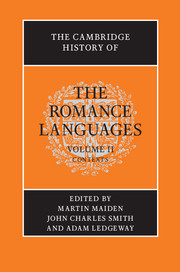Crossref Citations
This Book has been
cited by the following publications. This list is generated based on data provided by Crossref.
Leppänen, Ville
and
Alho, Tommi
2018.
On The Mergers Of Latin Close‐Mid Vowels.
Transactions of the Philological Society,
Vol. 116,
Issue. 3,
p.
460.
Greco, Paolo
2019.
On the notion of linguistic influence in syntax.
Belgian Journal of Linguistics,
Vol. 33,
Issue. ,
p.
11.
Mukuna, Robert Kananga
2020.
Exploring Basotho teenage fathers’ experiences of early fatherhood at South African rural high schools.
Journal of Psychology in Africa,
Vol. 30,
Issue. 4,
p.
348.
Ledgeway, Adam
and
Roberts, Ian
2020.
Introduction.
Probus,
Vol. 32,
Issue. 2,
p.
175.
MERLO, Roberto
2020.
“STELELE ȘI LALELELE”: SAGGIO DI MICROMONOGRAFIA STORICO DESCRITTIVA DI UNA CLASSE FLESSIVA DELLA LINGUA ROMENA (I).
Studia Universitatis Babeș-Bolyai Philologia,
p.
261.
Banniard, Michel
2020.
Les Wisigoths, des germanophones devenus latinophones.
Pallas,
p.
237.
Andreose, Alvise
2022.
Pregi e limiti di un approccio metalinguistico al problema della transizione latino-romanza.
Mélanges de l'École française de Rome. Moyen Âge,
p.
243.
Fesenmeier, Ludwig
2022.
Linguistik im Sprachvergleich.
p.
857.
De La Rosa Yacomelo, Johan
Ramírez González, Rudecindo
Viloria Rodríguez, Leonel
Valdez Jimenez, Wendy
and
Guerra-Lyons, Jesús
2023.
Lexical Borrowings from Spanish into Wayuunaiki: Contact, Classification, and Motivations.
Languages,
Vol. 8,
Issue. 3,
p.
169.
Banniard, Michel
2024.
De la romanisation du latin à la latinisation du roman (viiie-ixe siècles).
Revue des langues romanes,
Vol. Tome CXXVIII n°2,
Issue. ,



